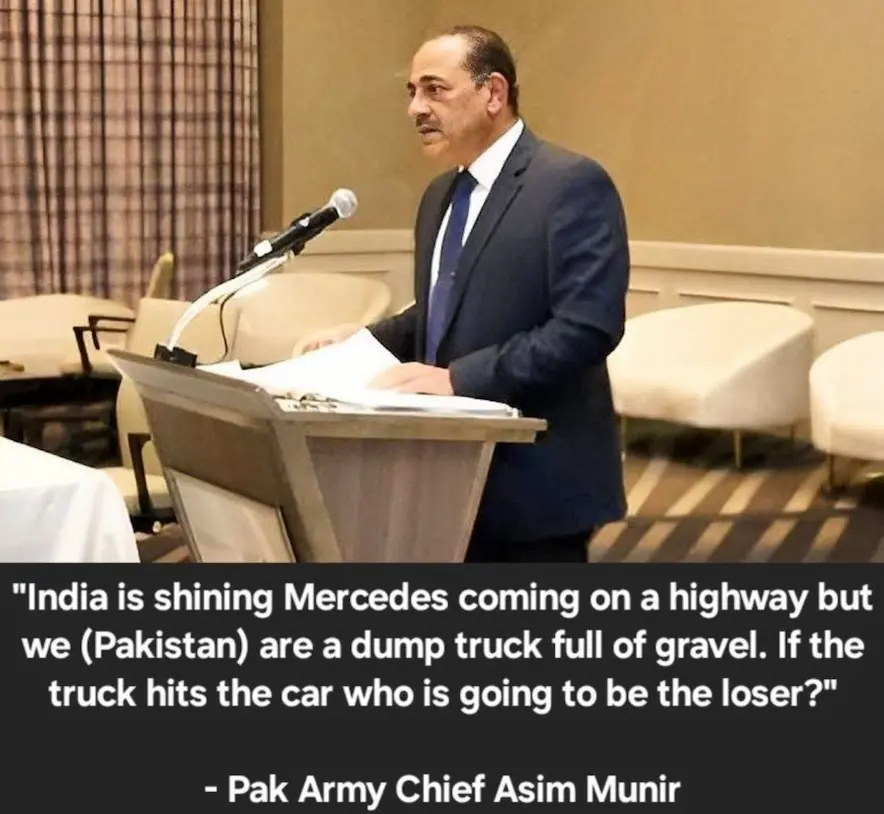
Pakistan Army Chief Asim Munir threatens India’s Jamnagar refinery
Asim Munir Alarming Threat to Jamnagar Refinery- In a provocative escalation of rhetoric, Pakistan Army Chief General Asim Munir has publicly threatened to target Reliance Industries Jamnagar refinery, the world’s largest single-site oil refining complex, in the event of future conflict with India. Speaking at a private dinner in Tampa, Florida, Munir referenced a social media post featuring Mukesh Ambani and a Quranic verse, implying an aerial strike on the refinery as symbolic retaliation.
Table of Contents
This marks a disturbing shift in Pakistan’s military posture: from targeting strategic installations to threatening economic infrastructure. India’s Ministry of External Affairs (MEA) swiftly condemned the remarks as “nuclear sabre-rattling” and “irresponsible,” reinforcing concerns about Pakistan’s military control and its ties to extremist groups.
But beyond the rhetoric lies a deeper question: Can Pakistan realistically threaten India’s economic assets without triggering overwhelming retaliation? Let’s unpack the threat, India’s defense capabilities, and the broader implications for regional stability.
The Threat: Why Jamnagar Was Chosen
The Jamnagar refinery, located in Gujarat, is not just an industrial facility, it’s a symbol of India’s economic might. Operated by Reliance Industries Limited (RIL), it processes over 33 million tonnes of crude oil annually, accounting for 12% of India’s refining capacity. It’s also a major exporter of petroleum products, making it a strategic asset in both domestic and global energy markets.
Munir’s threat was not random. By naming Mukesh Ambani, India’s richest man, and referencing a Quranic verse historically interpreted as an aerial attack, he signaled intent to strike at the heart of India’s economic power.
Jamnagar Refinery at a Glance
| Feature | Details |
| Location | Jamnagar, Gujarat |
| Operator | Reliance Industries Ltd |
| Annual Capacity | 33 million tonnes of crude |
| Share of India’s Capacity | 12% |
| Strategic Importance | Major exporter, economic symbol |
This is the first time a Pakistani military leader has publicly threatened India’s economic infrastructure, raising alarms across diplomatic and defense circles.
India’s Defense Capacity: A Reality Check for Munir
While Munir’s remarks may play well to domestic audiences, they vastly underestimate India’s military and strategic capabilities. India has spent the last decade modernizing its defense systems, particularly in air defense and missile interception.
Key Defense Assets
- S-400 Triumf Air Defense System: India’s acquisition from Russia has significantly enhanced its ability to intercept aerial threats. During recent skirmishes, the IAF reportedly used the S-400 to shoot down six Pakistani aircraft.
- Agni-V Missile System: With a range of 5,000–8,000 km, it can deliver nuclear payloads across Asia, including deep into Pakistan.
- Cold Start Doctrine: India’s rapid-response strategy allows for swift, localized strikes without crossing the nuclear threshold.
- Nuclear Arsenal: India now possesses an estimated 180 nuclear warheads, surpassing Pakistan’s 170, and is developing MIRV technology for multiple target engagement.
Military Comparison
| Metric | India | Pakistan |
| Active Personnel | 1.4 million | ~700,000 |
| Air Force Strength | 149,900 | 70,000 |
| Navy Strength | 75,500 | 30,000 |
| Paramilitary Forces | 2.5 million | ~500,000 |
| Nuclear Warheads | ~180 | ~170 |
| Missile Range (Agni-V) | 5,000–8,000 km | Shaheen-3: ~2,750 km |
India’s No First Use nuclear policy is backed by overwhelming conventional superiority, making any Pakistani strike on economic assets a suicidal gamble.
Diplomatic Fallout and Global Reactions
Munir’s remarks, made on U.S. soil, have drawn criticism not just from India but from international observers. The MEA called it “regrettable” that such threats were issued from a friendly third country, and former Pentagon analyst Michael Rubin likened Munir to “Osama Bin Laden in a suit.”
The timing is also notable. Munir’s comments came just months after Operation Sindoor, India’s retaliatory strikes against terror hubs in Pakistan following the Pahalgam attack. Pakistan’s response, missile and drone strikes, was largely neutralized by India’s air defense systems.
Global Concerns
- U.S. Silence: No official condemnation yet, raising questions about Washington’s stance.
- Regional Stability: Threats to economic infrastructure could destabilize energy markets.
- Nuclear Brinkmanship: Escalating rhetoric increases the risk of miscalculation.
India continues to engage diplomatically, reinforcing its zero-tolerance policy on terrorism while exposing Pakistan’s ties to extremist networks.
Final Thoughts on Asim Munir Alarming Threat: Rhetoric vs Reality
General Asim Munir’s threat to target Jamnagar may serve as a rallying cry for hardliners, but it’s a dangerous miscalculation. India’s defense infrastructure, strategic depth, and global alliances make such threats not only reckless but futile.
More importantly, targeting economic assets like Jamnagar crosses a line, from military confrontation to economic terrorism. It signals a shift in Pakistan’s doctrine that could invite unprecedented retaliation and global condemnation.
India, for its part, remains firm. As MEA spokesperson Randhir Jaiswal stated:
“India will not give in to nuclear blackmail and will take all steps to safeguard national security.”
In the end, the real question is not whether Pakistan can strike Jamnagar, it’s whether it can survive the consequences.
Also read – Half the World in Flames: Pakistan Nuclear Threat and the Global Fallout